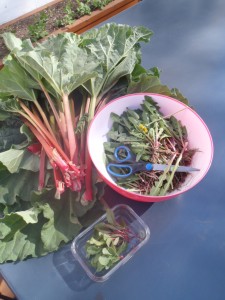We’ve tried a lot of things with dandelions. The leaves are great. Hopefully everybody knows that by now. I’ve made syrups with the flowers, but truthfully they don’t have much flavour and are only good for their sunny colour. The roots are delicious roasted and useful in bitter infusions, but they are such a bitch to harvest I rarely bother. The flower buds can be pickled, but while they look a good deal like capers they don’t actually have much flavour of their own, and certainly don’t have the distinct mustard-like pop of their Mediterranean look-alikes.
Dandelion crowns might be the tastiest part of the plant.
The crown is where the root transitions to the stalks. It is only slightly … Continue reading.
 At left is the first harvest from the yard, largely rhubarb and dandelions.
At left is the first harvest from the yard, largely rhubarb and dandelions.
Describing dandelions as “edible” is misleading. The term suggests that they should only be eaten in survival situations. (Would you ever describe spinach, or cheese, or pork, as merely “edible”?)
In reality, dandelions are a treasured leafy green in several European cuisines. They even have an entry in Larousse. Some excerpts from that article:
- “the English name is derived from the alternative French name dent-de-lion (literally ‘lion’s tooth’, referring to its serrated leaves)”
- “Wild dandelion leaves should be picked before the plant has flowered…, when they are small and sweet.” This line confuses me a bit. While our dandelion leaves are definitely better when small and
…
Continue reading.
The personal website of Edmonton chef Allan Suddaby
